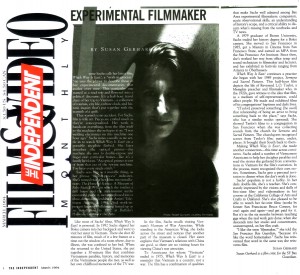Experimental Filmmaker Lynne Sachs
The Independent Film and Video Monthly
March, 1994
By Susan Gerhard
Lynne Sachs calls her latest film, Which Way is East?. A “work-in-process.” She uses the phrase to describe those of her experimental documentaries that evolve over time. This particular one started as a road trip and flowered into a political discourse: It’s a half-hour travel diary of her trip to Vietnam – a collection of tourism, city life, culture clash, and historic inquiry that’s put together with the warmth of a quilt.
That warmth is no accident. For Sachs, film is folk art. Pieces are crafted much as they’re conceptualized. Her work is hands-on everything, from the film itself to the machines she reshapes it on. “I was welding electronics on this machine one hour ago,” Sachs notes casually as we settle in to watch Which Way Is East? on a portable six-plate flatbed. She later describes the optical printer – the machine she uses to double-expose and linger over particular frames – like it’s a family heirloom. “An optical printer is sort of from that era of the sewing machine. You hear every single stitch.”
Sachs sees film as a mutable thing, as her phrase “film-in-process” indicates. She’s turned two of her films into installations: The House of Science: A Museum of False Facts (1991), in which she torches a doll house and the anti-feminist myths contained inside it, metamorphosed into a three-dimensional exhibit at Artists’ Television Access in 1991. And work-in-process States of UnBelonging turned up as an installation in 1992 at Buffalo’s Hallwalls Center for the Arts.
Like most of Sachs’ films, Which Way Is East? is personal. In 1992 Sachs slipped her Bolex camera into her backpack and went to visit her sister in Vietnam. There she shot 40 minutes of film, much of it a few frames at a time out the window of a room where, due to illness, she was confined to her bed. When she returned to the United States, she put together a 30-minute film that combines Vietnamese parables, history, and memories of the Vietnamese people she met, as well as her own childhood memories of the TV war.
In the film, Sachs recalls visiting Vietnam’s Museum of War Atrocities. While standing in the American Wing, she looks across the street and notices that another part of the museum is closed. Her sister explains that Vietnam’s relations with China are good, so there are no visiting hours for viewing China’s war atrocities.
To Americans for whom “Vietnam” ended in 1975, Which Way Is East? is a reminder that Vietnam is a country, not a war. The film has a combination of qualities that make Sachs well admired among Bay Area experimental filmmakers: compassion, acute observational skills, an understanding of history’s scope, and a critical ability to discern what’s missing from the textbooks and TV news.
A 1979 graduate of Brown University, Sachs traded her history degree for a Bolex camera. She moved to San Francisco in 1985, got a Masters in Cinema from San Francisco State, and earned an MFA from the San Francisco Art Institute. Since then, she’s worked her way from office temp and sound technician to filmmaker and lecturer, and has exhibited in festivals ranging from Atlanta to Oberhausen.
Which Way Is East? continues a practice she began with he 1989 project, Sermons and Sacred Pictures. This half-hour film depicts the life of Reverend L.O. Taylor, a Memphis preacher and filmmaker who, in the 1920s, gave witness to the idea that film, as a medium of self-representation, could affect people. He made and exhibited films of his congregations’ baptisms and daily lives.
“[Taylor] preserved something; [he used] that relationship of being an artist to bring something back to the place,” says Sachs, who has a similar modus operandi. She showed Taylor’s films to a congregation in San Francisco when she was collecting sounds from the church for Sermons and Sacred Pictures. The churchgoers recognized scenes from Taylor’s films: aunts, uncles, places. It brought their South back to them.
Making Which Way s East?, she made another connection – this time across continents. Sachs asked a number of Vietnamese Americans to help her decipher parables and read the stories she gathered from conversations in Vietnam for the film’s narration. In the process, many recognized their own stories. Sometimes, Sachs gets a personal invitation to dinner when the day’s work is done.
Sachs’ populism is not a hobby. In her daily double-life, she’s a teacher. She’s constantly impressed by the visions and skills of first-time film and videomakers in her courses at the California College of Arts and Crafts in Oakland. She’s also pleased to be able to watch her favorite films (works by former San Franciscan Bruce Conner, for one) again and again – and get paid for it. But it’s in the six months between teaching gigs when the real work gets done; when she descends into her studio and concentrates, uninterrupted, on her film craft.
“I like the term ‘filmmaker,’” she told the San Francisco Bay Guardian, “because it’s like the word homemaker,” Sachs has reinvented that word in the same way she reinvents film.
Susan Gerhard
Susan Gerhard is a film critic for the SF Bay Guardian.

